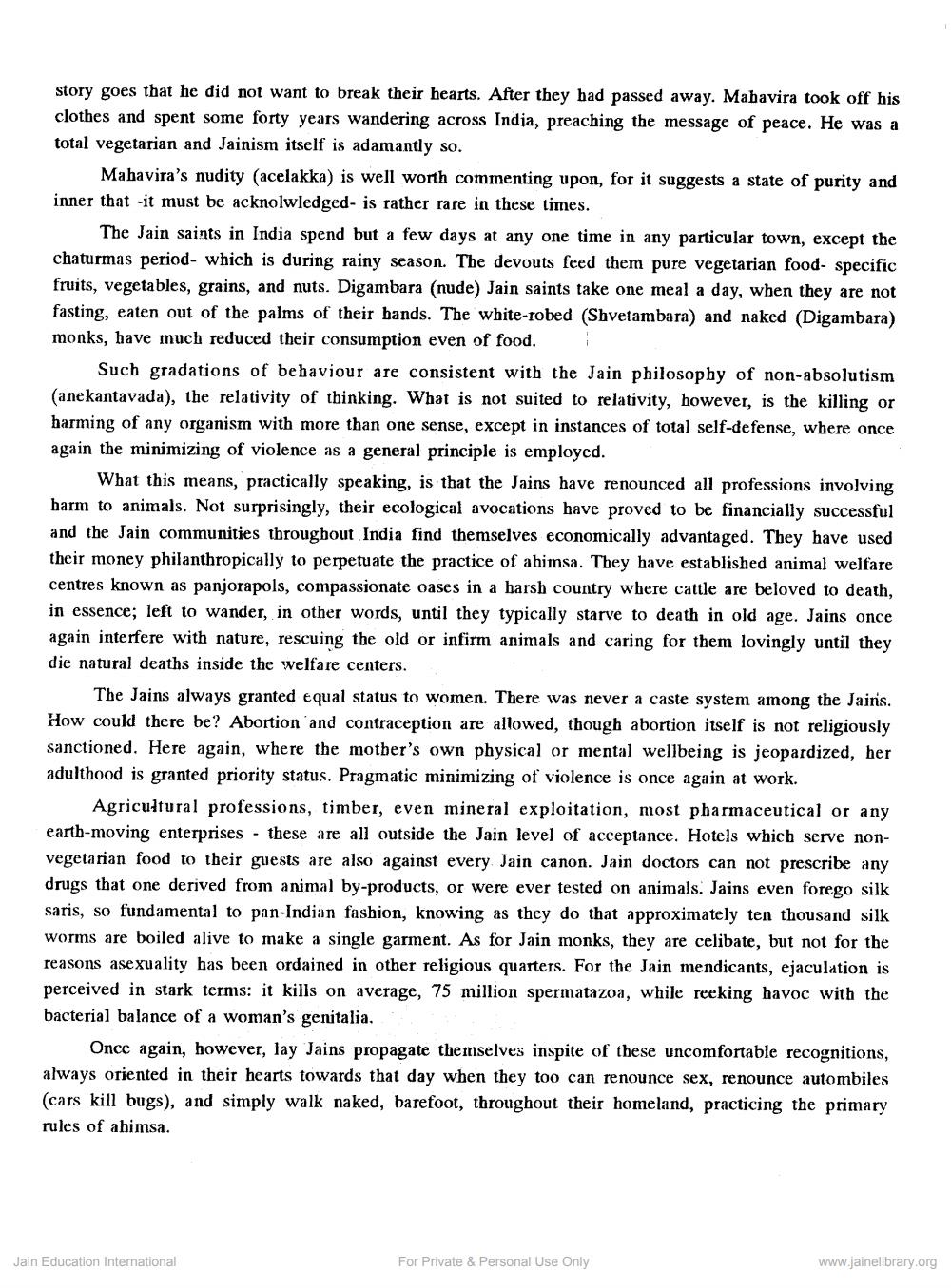________________
story goes that he did not want to break their hearts. After they had passed away. Mabavira took off his clothes and spent some forty years wandering across India, preaching the message of peace. He was a total vegetarian and Jainism itself is adamantly so.
Mahavira's nudity (acelakka) is well worth commenting upon, for it suggests a state of purity and inner that -it must be acknolwledged- is rather rare in these times.
The Jain saints in India spend but a few days at any one time in any particular town, except the chaturmas period- which is during rainy season. The devouts feed them pure vegetarian food- specific fruits, vegetables, grains, and nuts. Digambara (nude) Jain saints take one meal a day, when they are not fasting, eaten out of the palms of their hands. The white-robed (Shvetambara) and naked (Digambara) monks, have much reduced their consumption even of food.
Such gradations of behaviour are consistent with the Jain philosophy of non-absolutism (anekantavada), the relativity of thinking. What is not suited to relativity, however, is the killing or harming of any organism with more than one sense, except in instances of total self-defense, where once again the minimizing of violence as a general principle is employed.
What this means, practically speaking, is that the Jains have renounced all professions involving harm to animals. Not surprisingly, their ecological avocations have proved to be financially successful and the Jain communities throughout India find themselves economically advantaged. They have used their money philanthropically to perpetuate the practice of ahimsa. They have established animal welfare centres known as panjorapols, compassionate oases in a harsh country where cattle are beloved to death, in essence; left to wander, in other words, until they typically starve to death in old age. Jains once again interfere with nature, rescuing the old or infirm animals and caring for them lovingly until they die natural deaths inside the welfare centers.
The Jains always granted equal status to women. There was never a caste system among the Jains. How could there be? Abortion and contraception are allowed, though abortion itself is not religiously sanctioned. Here again, where the mother's own physical or mental wellbeing is jeopardized, her adulthood is granted priority status. Pragmatic minimizing of violence is once again at work.
Agricultural professions, timber, even mineral exploitation, most pharmaceutical or any earth-moving enterprises - these are all outside the Jain level of acceptance. Hotels which serve nonvegetarian food to their guests are also against every Jain canon. Jain doctors can not prescribe any drugs that one derived from animal by-products, or were ever tested on animals. Jains even forego silk saris, so fundamental to pan-Indian fashion, knowing as they do that approximately ten thousand silk worms are boiled alive to make a single garment. As for Jain monks, they are celibate, but not for the reasons asexuality has been ordained in other religious quarters. For the Jain mendicants, ejaculation is perceived in stark terms: it kills on average, 75 million spermatazoa, while reeking havoc with the bacterial balance of a woman's genitalia. it
Once again, however, lay Jains propagate themselves inspite of these uncomfortable recognitions, always oriented in their hearts towards that day when they too can renounce sex, renounce autombiles (cars kill bugs), and simply walk naked, barefoot, throughout their homeland, practicing the primary rules of ahimsa.
Jain Education International
For Private & Personal Use Only
www.jainelibrary.org




